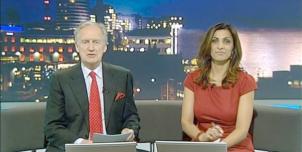Full Freeview on the Lark Stoke (Gloucestershire, England) transmitter
| Google map | Bing map | Google Earth | 52.082,-1.729 or 52°4'53"N 1°43'43"W | GL55 6LS |
The symbol shows the location of the Lark Stoke (Gloucestershire, England) transmitter which serves 38,000 homes. The bright green areas shown where the signal from this transmitter is strong, dark green areas are poorer signals. Those parts shown in yellow may have interference on the same frequency from other masts.
_______
Digital television services are broadcast on a multiplexes (or Mux) where many stations occupy a single broadcast frequency, as shown below.
64QAM 8K 3/4 27.1Mb/s DVB-T MPEG2
H/V: aerial position (horizontal or vertical)
The Lark Stoke (Gloucestershire, England) mast is a public service broadcasting (PSB) transmitter, it does not provide these commercial (COM) channels: .
If you want to watch these channels, your aerial must point to one of the 80 Full service Freeview transmitters. For more information see the will there ever be more services on the Freeview Light transmitters? page.
Which Freeview channels does the Lark Stoke transmitter broadcast?
If you have any kind of Freeview fault, follow this Freeview reset procedure first.Digital television services are broadcast on a multiplexes (or Mux) where many stations occupy a single broadcast frequency, as shown below.
64QAM 8K 3/4 27.1Mb/s DVB-T MPEG2
H/V: aerial position (horizontal or vertical)
The Lark Stoke (Gloucestershire, England) mast is a public service broadcasting (PSB) transmitter, it does not provide these commercial (COM) channels: .
If you want to watch these channels, your aerial must point to one of the 80 Full service Freeview transmitters. For more information see the will there ever be more services on the Freeview Light transmitters? page.
Which BBC and ITV regional news can I watch from the Lark Stoke transmitter?

BBC Midlands Today 2.9m homes 10.9%
from Birmingham B1 1RF, 45km north-northwest (345°)
to BBC West Midlands region - 66 masts.

ITV Central News 2.9m homes 10.9%
from Birmingham B1 2JT, 46km north-northwest (345°)
to ITV Central (West) region - 65 masts.
All of lunch, weekend and 80% evening news is shared with Central (East)
How will the Lark Stoke (Gloucestershire, England) transmission frequencies change over time?
| 1984-97 | 1997-98 | 1998-2011 | 2011-13 | 7 Mar 2018 | |||||
| A K T | A K T | A K T | K T | K T | |||||
| C23 | ITVwaves | ITVwaves | ITVwaves | D3+4 | D3+4 | ||||
| C26 | BBC2waves | BBC2waves | BBC2waves | BBCA | BBCA | ||||
| C29 | C4waves | C4waves | C4waves | ||||||
| C30 | -BBCB | BBCB | |||||||
| C33 | BBC1waves | BBC1waves | BBC1waves | SDN | |||||
| C36 | ArqA | ||||||||
| C41 | +SDN | ||||||||
| C44 | ArqA | ||||||||
| C47 | ArqB | ||||||||
| C48 | _local | _local |
tv_off Being removed from Freeview (for 5G use) after November 2020 / June 2022 - more
Table shows multiplexes names see this article;
green background for transmission frequencies
Notes: + and - denote 166kHz offset; aerial group are shown as A B C/D E K W T
waves denotes analogue; digital switchover was 6 Apr 11 and 20 Apr 11.
How do the old analogue and currrent digital signal levels compare?
| Analogue 1-4 | 6.3kW | |
| SDN, ARQA, ARQB, BBCA, D3+4, BBCB | (-7dB) 1.26kW | |
| Mux 1*, Mux 2*, Mux A*, Mux B*, Mux C*, Mux D* | (-24dB) 25W |
Local transmitter maps
Lark Stoke Freeview Lark Stoke AM/FM Lark Stoke TV region BBC West Midlands Central (West micro region)Which companies have run the Channel 3 services in the Lark Stoke transmitter area
|
Tuesday, 18 January 2011
G
Graham4:09 PM
Shipston-on-stour
Tuned to Lark Stoke, which my aerial can 'see'.
Why is Mux D (film 4, itv4 etc) so weak?
Have new aerial which should give me these reliably.
Have TV HD ready. Why can I not get HD (CH54) when I tune it to Freeview.
Is anything going to be better after April 20?
| link to this comment |
Graham's: mapG's Freeview map terrainG's terrain plot wavesG's frequency data G's Freeview Detailed Coverage
Wednesday, 19 January 2011
Graham: Multiplex D is not weak, it is the same power as all the other multiplexes. Please can you see Single frequency interference | ukfree.tv - independent free digital TV advice .
Freeview HD is not broadcast from this mast until Wednesday 20th April 2011, C54 is not used on this transmitter.
Freeview power increases from 25W (average) to 1,260W, 50 times stronger at switchover.
| link to this comment |
Tuesday, 8 February 2011
G
Geoffrey2:15 PM
Analogue BBC1 has a clicking noise on the sound as it switches between stero and mono every few seconds. Arqiva on their way.
Best wishes,
Geoffrey.
| link to this comment |
Sunday, 13 February 2011
A
Andrew5:17 PM
Hello
Can anyone tell me if the power is down from Larkstoke as all the digital BBC frequencies keep breaking up from our Stratford upon Avon address after spending £150 on a new aerial.
| link to this comment |
Andrew: The transmiiter is operating normally. Please see Freeview intermittent interference | ukfree.tv - independent free digital TV advice .
| link to this comment |
Tuesday, 15 March 2011
S
Syd Wall4:52 PM
Shipston-on-stour
I'm embarrassed to ask this as I am sure I should be able to work it out myself, but I haven't been able to so here goes. I live in Admington (postcode CV36 4JN), less than 2 miles from the Lark Stoke transmitter. I have two aerials on my roof (the reasons for which are lost in the mists of time - I can't remember), one pointing to Lark Stoke, one to Sutton Coldfield. One aerial feeds the TVs in the kitchen and bedroom, the other feeds to the main TV in the lounge. How can I tell if the lounge TV is receiving from Lark Stoke or Sutton Coldfield?
| link to this comment |
Syd's: mapS's Freeview map terrainS's terrain plot wavesS's frequency data S's Freeview Detailed Coverage
Syd Wall- When tuning the equipment, it should show the channel number(frequency) for each MUX. Simply note the numbers and compare with each transmitter.
| link to this comment |
Wednesday, 16 March 2011
S
Syd Wall9:13 AM
Shipston-on-stour
Thanks LutonFan. I knew it would be simple. I'll point both aerials to Lark Stoke so I can take advantage of Lark Stoke's earlier analogue switch off.
| link to this comment |
Syd's: mapS's Freeview map terrainS's terrain plot wavesS's frequency data S's Freeview Detailed Coverage
Tuesday, 29 March 2011
S
Syd Wall12:15 PM
Shipston-on-stour
Hi again - the Lark Stoke transmitter starts digital switchover next Wednesday, with the first stage being 'PSB1 starts on C26'.
Then on Apr 20th, we get this:
"Freeview power increases from 25W (average) to 1,260W, 50 times stronger.
COM4 starts on C41. COM5 starts on C44. COM6 starts on C47. NEW7 starts on C48. PSB2 starts on C23. PSB3 starts on C30".
I presume that some time on Wed Apr 6th, I must do a rescan. But all the action seems to be on the 20th, when I rescan again. So what will I notice on Apr 6th? What happens between the 6th & 20th? What are COM/NEW/PSB?
Thanks
| link to this comment |
Syd's: mapS's Freeview map terrainS's terrain plot wavesS's frequency data S's Freeview Detailed Coverage
M
Mike Dimmick1:32 PM
Reading
Syd Wall: On 6 April, the existing Multiplex 1 closes, as does BBC Two analogue. The new BBC A multiplex (PSB1) starts up on C26, replacing BBC Two analogue. Multiplex B will move to C21 for the two-week period between DSO1 and DSO2.
BBC One, BBC Two, BBC Three, CBBC, BBC News and the other services currently on Multiplex 1 will stop working unless you retune. You will also lose the services on Multiplex B although all the BBC services will be duplicated on BBC A, which is their permanent home. (Sky Sports' permanent home is on the ArqB multiplex.)
Then, on 20th April, Multiplex 2 and B will close, along with BBC One, ITV and Channel 4 analogue. D3+4 starts up on C23 and BBC B (HD channels) starts up on C30. Multiplex A continues unchanged. Multiplexes C and D change to their final mode, becoming ArqA and ArqB, but for now stay at their current power level and channel.
Services will be off-air until 6am on the DSO days. You should retune after that time.
COM/NEW/PSB: There are six multiplexes. Ofcom classifies them as Public Service Broadcasting (PSB), multiplexes operated by the public service broadcasters: the BBC, ITV and Channel 4, and Commercial (COM), operated by SDN Limited and Arqiva Services Limited (two multiplexes). NEW are potential new multiplexes that could be licensed in future: see the Interleaved Spectrum page, although the actual allocations are speculative at this stage and in my view shouldn't be shown here, because they're just confusing.
The multiplexes are also called by the name of the license holder: PSB1 is BBC A, PSB2 is Digital 3 & 4 (D3&4 or D3+4), PSB3 is BBC B or HD (reflecting its use), COM4 is SDN, COM5 is Arqiva A or ArqA, and COM6 is Arqiva B (ArqB).
This webpage ought to be consistent and refer to BBC A rather than PSB1, etc.
Before switchover they were known by numbers and letters, the original PSB multiplexes getting numbers (1 for BBC, 2 for ITV and C4) and the original commercial multiplexes getting letters (A for SDN, B for BBC Free To View Ltd, C for Arqiva A, D for Arqiva B). The BBC has B because originally onDigital/ITV Digital had B, C and D and they were reauctioned when ITV Digital went bust. Ofcom has basically stolen Multiplex B back from the BBC for HD services.
| link to this comment |
Mike's: mapM's Freeview map terrainM's terrain plot wavesM's frequency data M's Freeview Detailed Coverage
Select more comments
Your comment please!




